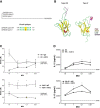SAG2A protein from Toxoplasma gondii interacts with both innate and adaptive immune compartments of infected hosts
- PMID: 23735002
- PMCID: PMC3706231
- DOI: 10.1186/1756-3305-6-163
SAG2A protein from Toxoplasma gondii interacts with both innate and adaptive immune compartments of infected hosts
Abstract
Background: Toxoplasma gondii is an intracellular parasite that causes relevant clinical disease in humans and animals. Several studies have been performed in order to understand the interactions between proteins of the parasite and host cells. SAG2A is a 22 kDa protein that is mainly found in the surface of tachyzoites. In the present work, our aim was to correlate the predicted three-dimensional structure of this protein with the immune system of infected hosts.
Methods: To accomplish our goals, we performed in silico analysis of the amino acid sequence of SAG2A, correlating the predictions with in vitro stimulation of antigen presenting cells and serological assays.
Results: Structure modeling predicts that SAG2A protein possesses an unfolded C-terminal end, which varies its conformation within distinct strain types of T. gondii. This structure within the protein shelters a known B-cell immunodominant epitope, which presents low identity with its closest phyllogenetically related protein, an orthologue predicted in Neospora caninum. In agreement with the in silico observations, sera of known T. gondii infected mice and goats recognized recombinant SAG2A, whereas no serological cross-reactivity was observed with samples from N. caninum animals. Additionally, the C-terminal end of the protein was able to down-modulate pro-inflammatory responses of activated macrophages and dendritic cells.
Conclusions: Altogether, we demonstrate herein that recombinant SAG2A protein from T. gondii is immunologically relevant in the host-parasite interface and may be targeted in therapeutic and diagnostic procedures designed against the infection.
Figures





References
-
- Montoya JG, Rosso F. Diagnosis and management of toxoplasmosis. Clin Perinatol. 2005;32:705–726. - PubMed
Publication types
MeSH terms
Substances
LinkOut - more resources
Full Text Sources
Other Literature Sources

